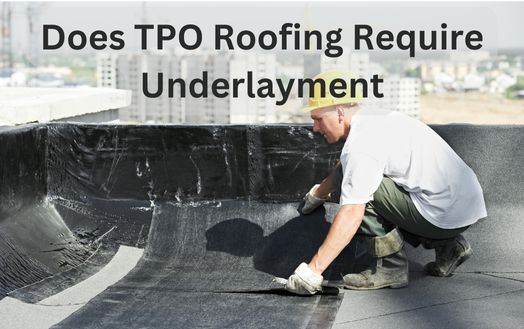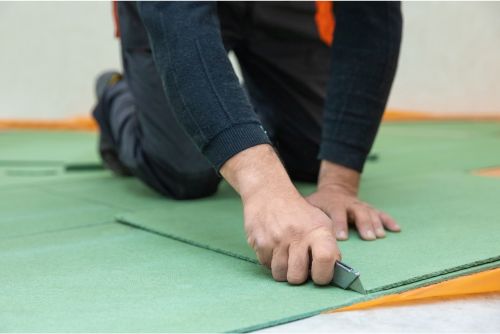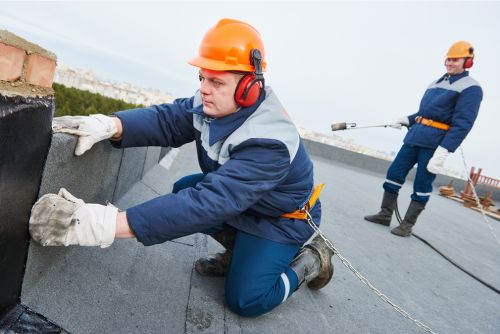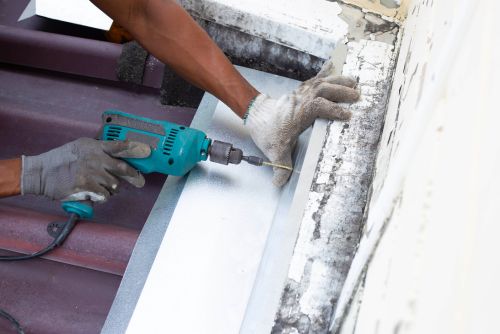
TPO (thermoplastic polyolefin) roofing has become increasingly popular in recent years, especially for commercial buildings. Its energy efficiency, reflective properties, and long lifespan make it an attractive choice for many property owners. However, one question that often arises is does TPO roofing require underlayment. In this blog, we will explore the basics of TPO roofing, its benefits, and discuss the necessity of underlayment in the installation process.
Before delving into whether underlayment is necessary for TPO roofing, let’s first understand what TPO roofing is. TPO roofing material is a type of roofing membrane made from thermoplastic polyolefin. It is a popular roofing material choice, known for its energy efficiency, reflective properties, and ability to withstand weather conditions. TPO roofing membranes are increasingly used for flat roofs, especially in commercial building projects. Now, let’s dive deeper into the basics of TPO roofing.
TPO roofing material is a type of roofing membrane made from thermoplastic polyolefin. It is a single-ply roofing material that offers energy savings, particularly in sunny climates. TPO roofing membranes are known for their reflective properties, making them ideal for commercial flat roofs. They come in lighter colors, which reflect ultraviolet (UV) rays, helping to keep the building cool and reduce energy costs.
TPO roofing material has gained popularity as an alternative to other types of roofing materials, such as metal roofing or asphalt shingles. It provides long-term energy savings while maintaining durability and weather resistance. TPO roofing material is also easier to install compared to other roofing materials, making it a popular choice for new roof installations.
One of the key benefits of TPO roofing is its energy efficiency. The reflective properties of TPO roofing material help to reduce heat absorption, keeping the building cooler and reducing energy consumption for air conditioning. This energy efficiency can lead to significant cost savings in the long run.
Additionally, TPO roofing material offers excellent resistance to UV rays. UV rays from the sun can cause damage to roofing materials over time, leading to premature aging and deterioration. TPO roofing’s reflective properties protect the membrane from UV damage, increasing its lifespan and reducing maintenance costs.
Furthermore, TPO roofing’s reflective properties contribute to its energy savings. By reflecting sunlight, TPO roofing material helps to reduce heat transfer into the building, resulting in lower energy needs for cooling. This energy savings can have a significant impact on energy costs, particularly in sunny climates or for buildings with high cooling requirements.
Another benefit of TPO roofing material is its durability. It is resistant to weather conditions, including extreme temperatures, rain, and snow. TPO roofing has been proven to withstand the test of time, making it a reliable choice for commercial roofing systems. Its long lifespan contributes to its cost-effectiveness and makes it a popular choice for property owners.
Overall, TPO roofing material offers a range of benefits, including energy efficiency, UV resistance, reflective properties, and long-term cost savings. These advantages make TPO roofing a popular choice for commercial building projects and new roof installations.
Now that we have explored the basics and benefits of TPO roofing, let’s compare it to other types of single-ply roofing membranes, such as EPDM and PVC. Understanding the differences between these materials can help property owners make informed decisions about their roofing needs.
TPO roofing material and EPDM roofing material are two popular options for single-ply roofing systems. While they have similarities, there are some key differences to consider when choosing between the two.
TPO roofing material and EPDM roofing material have specific installation processes. TPO roofing material is heat-welded at the seams, creating a monolithic roofing system that is resistant to water infiltration. On the other hand, EPDM roofing material is typically adhered using adhesives or ballasting techniques, which can be more labor-intensive.
Both TPO roofing material and EPDM roofing material offer long lifespan, but TPO roofing has gained popularity for its energy efficiency and reflective properties. EPDM roofing, also known as ethylene propylene diene monomer, is highly durable and weather-resistant, making it suitable for various weather conditions.
When it comes to insulation boards, TPO roofing material and EPDM roofing material have specific requirements. TPO roofing systems often require cover boards to be installed over the roof deck before the membrane is applied. EPDM roofing systems, on the other hand, may not require cover boards but may require insulation boards to be installed under the membrane.
In terms of popularity, TPO roofing material and EPDM roofing material are widely used for roofing services, especially in commercial buildings. Both materials have their advantages, and the choice between the two depends on specific needs, weather conditions, and installation preferences.
Another comparison to make when considering TPO roofing is polyvinyl chloride (PVC) roofing material. Like TPO roofing, PVC roofing material is a type of single-ply roofing membrane. Comparing TPO roofing to PVC roofing can help property owners understand the differences and make informed decisions.
TPO roofing material and PVC roofing material also have specific installation processes. TPO roofing material is heat-welded at the seams, creating a monolithic roofing system that is resistant to water infiltration, similar to EPDM roofing. PVC roofing material, on the other hand, is typically installed using adhesives or mechanical fasteners.
Both TPO roofing material and PVC roofing material offer energy efficiency, with reflective properties that help reduce heat absorption and energy consumption for cooling. They are popular options for commercial roofing systems, providing long-term cost savings.
In terms of insulation boards, like EPDM roofing, TPO roofing systems may require cover boards to be installed over the roof deck before the membrane is applied. PVC roofing systems, however, may not require cover boards but may require insulation boards.
When considering TPO roofing vs. PVC roofing, it’s important to evaluate specific needs, weather conditions, and installation preferences. Both materials offer durability, weather resistance, and energy efficiency, making them suitable options for commercial roofing projects.

Let’s now shift our focus to the necessity of underlayment in TPO roofing installations. Does TPO roofing require underlayment? Underlayment plays an important role in roofing systems, but is it necessary for TPO roofing? Let’s explore the role of underlayment in roofing and understand its specific requirements for TPO roofing systems.
Underlayment serves several important purposes in roofing systems, regardless of the type of roofing material used. It acts as a vapor barrier, preventing moisture from reaching the roof deck and insulation layer. Underlayment also helps provide additional insulation, improving the energy efficiency of the roofing system.
When it comes to TPO roofing, underlayment plays a crucial role in ensuring the long-term performance of the roof. It acts as a barrier, preventing moisture from seeping into the insulation layer and potentially causing damage. Without proper underlayment, water infiltration can lead to insulation degradation, compromising the energy efficiency of the roofing system.
Additionally, underlayment helps create a smooth surface for the TPO roofing membrane installation, ensuring proper adhesion and reducing the risk of membrane damage. It provides an extra layer of protection against weather conditions, such as hail or wind-driven rain.
It’s important to note that the specific underlayment requirements for TPO roofing systems may vary depending on factors such as building codes, climate conditions, and manufacturer recommendations. Consulting with commercial roofing contractors NJ and professionals is essential to ensure the right type of underlayment is selected and installed correctly for optimal roof performance.
When it comes to underlayment for TPO roofing systems, there are specific considerations to keep in mind. TPO roofing systems often require cover boards to be installed over the roof deck before the membrane is applied. These cover boards provide a flat, stable surface for the TPO roofing membrane installation, protecting the insulation layer and enhancing the overall performance of the roofing system.
In addition to cover boards, underlayment specific to TPO roofing systems may be required. Propylene underlayment is commonly used as the underlayment material for TPO roofing systems. Propylene underlayment serves as a vapor barrier, preventing moisture from infiltrating the roof deck and insulation layer, and maintaining the energy efficiency of the roof.
It’s important to follow manufacturer instructions and guidelines when installing underlayment for TPO roofing systems. Proper installation techniques, including appropriate fastening methods and layering, are crucial to ensure the underlayment’s effectiveness and long-term performance.
By incorporating underlayment into TPO roofing systems, property owners can enhance the roof’s durability, energy efficiency, and overall lifespan. Consulting with roofing professionals is highly recommended to determine the specific underlayment requirements for TPO roofing installations.

Now that we understand the basics of TPO roofing and the importance of underlayment, let’s take a closer look at the installation process. Proper installation is imperative to ensure the longevity and performance of the TPO roofing system.
The installation process of TPO roofing starts with preparing the roof. This step is crucial for the success of the installation and involves thorough cleaning, inspection, and preparation of the roof deck.
Roofing contractors typically begin by cleaning the roof surface, removing any debris, dirt, or existing roofing materials. This ensures a clean and smooth base for the TPO membrane installation. Any damage or deterioration to the roof deck is also inspected and repaired, if necessary, to ensure a solid foundation for the TPO roofing system.
For flat roofs, proper roof decking is crucial. The roof deck should be flat, level, and structurally sound, capable of supporting the TPO roofing system. If there are any issues with the roof deck, they should be addressed before proceeding with the installation.
Commercial roof replacement NJ is another consideration. If the existing roofing material needs to be removed, it should be done carefully to prevent any damage to the roof deck. Removing the old roof materials and preparing the roof deck for TPO installation may require professional expertise, ensuring a seamless and successful installation process.
Once the roof is properly prepared, the installation of the TPO roofing membrane can begin. This step involves setting the TPO material in place, ensuring proper alignment, and securing it to the roof deck.
TPO roofing material is supplied in rolls, which are laid out and cut to size according to the specific dimensions of the roof. The membrane is then positioned carefully, avoiding any stretching or tearing, and ensuring proper alignment with edges, corners, and penetrations.
Before securing the TPO membrane to the roof deck, insulation boards may need to be installed. These boards provide additional insulation and enhance the energy efficiency of the roofing system. They are typically fastened to the roof deck using mechanical fasteners, adhesive, or other approved methods.
Once the insulation boards are in place, the TPO roofing system installation can continue. Heat welding is commonly used to bond the TPO material to the roof deck, creating a strong, watertight seal. A heat gun is used to heat weld the membrane, fusing adjacent panels together and forming a monolithic roofing system.
The installation process of TPO roofing requires precise techniques and tools, such as heat welders, to ensure proper adhesion and create a durable, long-lasting roofing system.
One critical step in TPO roofing installation is heat-welding the TPO seams. Seams are the areas where adjacent panels of TPO roofing material meet, and proper heat-welding at these seams is crucial to create a durable, monolithic roofing system.
Heat-welding involves using a heat gun to heat the TPO material, softening it and allowing adjacent panels to fuse together. The heat gun’s precise temperature control ensures consistent and reliable seam welding, resulting in a strong, watertight bond.
When heat-welding TPO seams, it’s essential to follow the manufacturer’s instructions and proper heat-welding techniques. This ensures the correct temperature, speed, and pressure are applied, resulting in well-sealed seams that are resistant to water infiltration.
Proper heat-welding of TPO seams is important for the overall integrity of the roofing system, particularly in areas prone to heavy rain, snow, or extreme weather conditions. Heat-welded seams provide added protection against water penetration, ensuring the TPO roofing system’s long-term performance.

While TPO roofing offers a range of benefits, it’s essential to consider the cost implications of TPO roofing installations. Understanding the price factors and cost per square foot of TPO roofing can help property owners make informed decisions about their roofing needs.
The cost of TPO roofing installations can vary depending on several factors. Labor costs, installation costs, roofing services, and specific project requirements all contribute to the overall price of TPO roofing systems.
Labor costs play a significant role in the total cost of TPO roofing installations, as skilled professionals are required to ensure proper installation and optimal roof performance. The complexity of the installation, roof size, and specific project needs can impact labor costs.
Installation costs, which include materials, underlayment, insulation boards, adhesives, and fasteners, also contribute to the overall expense of TPO roofing systems. The type and quality of materials selected, as well as any additional services required, can influence installation costs.
The square foot of roof area to be covered is another important factor when determining the cost of TPO roofing. The larger the roof, the higher the price, as more materials, labor, and time are required for installation. Specific roof features, such as penetrations or vents, may also impact the overall cost of the roofing system.
Property owners should consult with professional commercial roofing company NJ to obtain accurate cost estimates for TPO roofing installations. By considering labor costs, installation costs, roofing services, and square foot requirements, property owners can make informed decisions about their roofing needs within their budget constraints.
When analyzing the cost of TPO roofing, it’s helpful to consider the cost per square foot. TPO roofing material costs are often measured per square foot, taking into account the specific type of material and its thickness.
The cost per square foot of TPO roofing systems includes material costs, installation costs, labor costs, and any additional services required. The square foot measurement represents the roof area to be covered, including any specific shape, roof features, or penetrations.
It’s important to note that TPO roofing material costs per square foot may vary depending on factors such as geographic location, availability, and specific project requirements. Commercial roofing systems, which often require larger roof areas to be covered, may have different cost considerations compared to residential roofing projects.
When evaluating TPO roofing costs, property owners should consider the long-term benefits of the material, including energy savings, durability, and lifespan. While TPO roofing may have a higher cost per square foot compared to other roofing materials, its long-term cost-effectiveness and energy efficiency make it a worthwhile investment, particularly for new roof installations.
Consulting with professional roofing services, contractors, and suppliers can provide helpful information on specific costs and options for TPO roofing systems, ensuring property owners make the right choice for their roofing needs.

Now that we’ve explored the cost implications of TPO roofing, let’s discuss the lifespan and maintenance considerations for TPO roofing systems. Understanding the lifespan of TPO roofing, as well as proper maintenance practices, can help property owners ensure their roofing systems perform optimally for years to come.
A well-maintained TPO roof can have a lifespan of upwards of 30 years, making it a long-lasting roofing option for commercial buildings. The life expectancy of TPO roofing systems depends on various factors, including installation quality, maintenance, weather conditions, and specific project requirements.
Regular maintenance and inspections play a key role in prolonging the lifespan of TPO roofing. Property owners should schedule regular cleaning, inspections, and maintenance to ensure any potential issues, such as damage, wear and tear, or seam failures, are addressed promptly. Regular cleaning of the roof can help preserve its reflective properties, energy efficiency, and overall performance.
When properly maintained, TPO roofing systems can provide long-term reliability, durability, and weather resistance. Regular maintenance, combined with professional inspections, can help identify and address any potential issues, ensuring the roof continues to perform optimally for its expected lifespan.
Maintaining a TPO roof is essential to ensure its long-term performance and durability. Regular cleaning, inspections, and maintenance practices should be followed, particularly in commercial buildings and sunny climates.
Regular cleaning of the TPO roof helps remove dirt, debris, and organic matter that can accumulate over time. This cleaning process helps preserve the roof’s reflective properties, energy efficiency, and overall appearance. Pressure washing or gentle cleaning solutions can be used, depending on the specific needs of the roof and the manufacturer’s recommendations.
In addition to regular cleaning, professional inspections should be conducted to identify any damage, wear, or potential issues that may arise. Inspections should include checking the roof seams, flashings, and the overall condition of the TPO membrane. Regular inspections help detect any early signs of deterioration, ensuring prompt maintenance and minimizing the risk of major roof problems.
Specific maintenance practices for TPO roofs, such as applying reflective roof coatings, may be recommended depending on the specific needs of the commercial building and the climate conditions. These additional maintenance practices can further enhance the roof’s energy efficiency, lifespan, and overall performance.
Property owners should consult with professional roofers experienced in TPO roofing maintenance to obtain specific guidelines and recommendations for their commercial building project. By following regular cleaning, maintenance, and inspection practices, property owners can ensure their TPO roof performs optimally for its intended lifespan.
Now, let’s address some common questions that arise when considering TPO roofing. Understanding the durability, walkability, and maintenance requirements of TPO roofing systems can help property owners make informed decisions.
TPO roofing material is known for its durability and resilience, making it a popular choice for commercial roofing systems. It can withstand various weather conditions, including extreme temperatures, rain, and snow.
When properly installed and maintained, TPO roofing systems offer long-term performance, ensuring the building remains protected and watertight. Its durability makes it a suitable choice for commercial buildings, even in colder climates where weather conditions can be more demanding.
It’s worth noting that the durability of TPO roofing systems can be further enhanced by regular maintenance, inspections, and addressing any potential issues promptly. By following best practices for TPO roofing maintenance, property owners can maximize the durability and longevity of their roofing system.
Walking on a TPO roof is a common concern for property owners, especially during maintenance or inspection activities. While TPO roofing systems are designed to withstand foot traffic, there are specific considerations to keep in mind to ensure the roof’s long-term performance.
Here are some important points to consider regarding walking on a TPO roof:
Like any roofing system, TPO roofing requires regular maintenance to ensure its long-term performance, durability, and energy efficiency. Regular maintenance practices can help identify and address any potential issues promptly, minimizing the risk of major roof problems.
Here are some key points to consider regarding regular maintenance for TPO roofing:
In conclusion, TPO roofing is a durable and cost-effective option for commercial and residential buildings. Its benefits, such as energy efficiency, resistance to UV rays, and ease of installation, make it a popular choice among property owners. While TPO roofing does not necessarily require underlayment, it can provide additional protection and insulation for your roof. Underlayment can help prevent commercial leak repair NJ and extend the lifespan of your TPO roof. Ultimately, the decision if does TPO roofing require underlayment depends on various factors, such as the climate and specific requirements of your building. Consult with a professional roofing contractor to determine the best approach for your TPO roofing project. With proper installation and maintenance, your TPO roof can provide long-lasting performance and peace of mind.